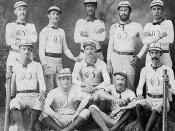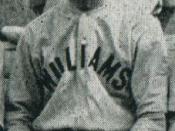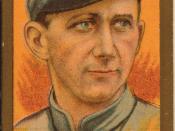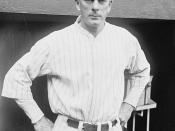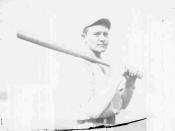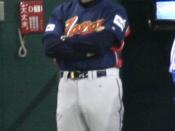According to ancient mythology, and particularly Arthurian legend, the vegetative cycle is based on nature, particularly on the cycle of the seasons. The myth states that everyone and everything goes through a cycle of death and resurrection, and the same goes for failure and redemption. For every fall there is a rise and for every rise there is a fall, and this notorious cycle is evident in a great deal of literature, past and present. Throughout the novel The Natural by Bernard Malamud the presence of the vegetative cycle parallels the life of the constantly struggling baseball player Roy Hobbs. Since Roy is continuously rising and falling he can never ultimately ÃÂwinÃÂ or ÃÂloseÃÂ at the end of the novel or at the end of both his career and his life. But even with that being true, Roy still faces many extreme failures and some very obvious points of redemption as well.
The combined efforts throughout the novel of Roy to become the best he can be in the game of baseball and the failures that come with those efforts are what give him the label of the ÃÂfallen heroÃÂ. Roy Hobbs is not self-sufficient though, as many of the other characters in the novel, including Memo Paris, Iris Lemon, Pop Fisher, and Judge Goodwill Banner all in some way contribute to the label termed by Roy.
In the beginning of the novel, the character that most influences Roy when his life was at its high ends was his friend and baseball scout, Sam Simpson. Sam was the character to initially recognize RoyÃÂs baseball talent and he put a large amount of exertion into displaying RoyÃÂs abilities. When Roy was only a young man, at the age of nineteen, it was with Sam SimpsonÃÂs encouragement and support that he was able to defeat a long-time legend, Walter (the Whammer) Wambold in a brief competition of talent. Thistriumphant victory at such a young age began Roy HobbsÃÂ baseball story on very good terms. But just as the vegetative cycle suggests, that ascent in RoyÃÂs life was surely to be followed by a descent. This drop came exceptionally quick though, because almost in the same instant that Roy was celebrating his victory, his was also commemorating the death of his good friend Sam Simpson. The impact from RoyÃÂs tremendous pitching had done serious damage to SamÃÂs body and he was unable to survive the train ride to RoyÃÂs first tryout. This was a major setback for Roy and he went from being a hero in the eyes of all that witnessed his defeat over the Whammer, to a slumping young man, lost in the world of baseball:ÃÂRoy trailed the anonymous crowd out of the Northwest Station and clung to the shadowy part of the wall till he had the courage to call a cabÃÂ (Malamud 32).
After SamÃÂs death Roy was clinging to the shadows of the world, when he had just recently stood out in the crowd, and proved himself a worthy player. This ÃÂslumpÃÂ is only the first of many major depressions that Roy goes through before he makes a final triumphant comeback.
Following the recurring path of the vegetative cycle, RoyÃÂs life was destined to come across a time of reincarnation, a time a redemption. He finds this liberation in a beautiful woman that he met on the same train ride to his first tryout. Her name is Harriet Bird, and to RoyÃÂs surprise she wants to meet him again at her hotel room. This makes Roy feel good about himself: ÃÂThen he was elatedÃÂ He combed his hair and got out his bassoon case. In the elevator a drunk tried to take it away from him but Roy was too strong for himÃÂ (Malamud 34).
As his spirits were once again lifted, Roy ventured on in hopes to find a relief in this woman. Instead, what he found was the greatest downfall of his life, and certainly of his career. What Roy found waiting in the room of Harriet Bird was in fact the beautiful woman, but this time she was armed with a weapon and did not hesitate to use it, shooting Roy in the stomach, leaving him wounded on the floor. This devastating moment ended RoyÃÂs dream of becoming a baseball star for a significant amount of time. So far his life was paralleling the vegetative cycle very closely and this pattern surely did not end there on the floor of the hotel room.
The next major point of redemption in the life of Roy Hobbs came when he was much older, at age thirty-four, healed from his past and ready to take on the baseball life once again. Roy got a break when he was signed to play for the New York Knights, a decent baseball team headed by a worn-out wannabe farmer , a former player by the name of Pop Fisher. At first, Pop has doubts about Roy, mainly because of his age, but after seeing how well he plays, even after his injuries, Pop welcomes Roy to the baseball team, and sets Roy up for the rest of his career. His moment of rejuvenation continues when Roy experiences his first time at bat in the major leagues. Roy's hit coincides with an immediate downpour, and the rain continues for three days. The hit is not only a rejuvenation for Roy, showing his regained talent and power, but a rejuvenation for the KnightÃÂs dried up baseball field, as the rain gives rebirth to the grass and to the team as a whole. This moment in the novel is an obvious comparison to the Arthurian myth of the vegetative cycle and it once again gives Roy the qualities of a hero that he had once had as a teenager on his way to his first shot at the major leagues.
Just as before and always, the hero-like moments that Roy stumbles upon are not complete without a touch of failure. The next let down of RoyÃÂs life comes when he is brutally rejected by a love interest of his, Memo Paris. Although Roy knew that Memo was still mourning the recent death of a Knights baseball player at the time, he still tried to pursue her. On Roy Hobbs Day at the Knights field, Roy had achieved a date with Memo. When she rejected him later on, he was very upset and even slightly angered. This shows the continuation of the vegetative cycle playing out because it carries on from the beginning when Roy beat the Whammer and then was wounded by Harriet Bird and now continues when he defeats Bump and becomes the best player on the Knights, and now is abandoned by Memo. Replacing Bump is still too painful for Memo and it shows the failure of Roy as the new hero. This point in the novel is the beginning of RoyÃÂs baseball slump and from this point on he starts to play poorly. The Knights and Pop Fisher slowly begin to lose hope for the end of the season.
Although some of the characters of the novel now start to lose their grip on RoyÃÂs interpretation as a hero, there are a few that still believe in him, and one of these characters becomes key to Roy and the vegetative myth. As Roy was batting poorly one day, he happened to notice a woman stand up in the crowd as if to cheer him on. That woman turns out to be Iris Lemon and she is one of the only characters at this point in the novel to recognize Roy as a true hero, when nobody else does the same, telling Roy that she stood up for him at the game, ÃÂBecause I hate to see a hero fail. There are so few of themÃÂ (Malamud 148). Roy meets up with Iris later and finds that he can confide in her like he could not confide in Memo. Following the vegetative cycle, Iris comes into the picture to give Roy a moment of redemption in his life. She also represents living, rebirth, and rejuvenation in the vegetative myth because it is revealed that she is a mother, and later that she is also a grandmother.
As Iris begins to slip RoyÃÂs mind, he goes back to thoughts of Memo Paris, and begins his once again inevitable downfall. Roy strays from the vegetative myth that Iris represents and nothing but failure comes of it. He visits Memo in Boston and then begins to play poorly again. He loses the KnightsÃÂ winning streak and they start to fall behind once again. At this point in the novel, Roy begins to look like a lost hope, because he goes through the cycle of failure and redemption so much, and he begins to focus on one of the things that makes him a failure, although he does not realize this. It starts to become suspicious whether or not Roy will ultimately become a failure, but according to the vegetative cycle, that is not a possibility.
With the hope that he cannot simply fail in the end, the ÃÂfallen heroÃÂ must be faced with yet another moment of redemption. This moment comes when Roy makes a fool of a close friend of MemoÃÂs and she decides to throw an early congratulatory party for the success of the Knights. Once again Roy is at the top of the of his game and he is also gaining confidence that he can finally win over the heart of Memo. In the same instant of happiness, just like the train ride of his past, Roy was brought down to an extreme level of low in his life. He had become very ill after the party and was then forced to stay in the hospital. He was told that the end of his baseball career was the only choice for him, and everything that he had ever hoped to become was lost.
As if this were not enough of a failure in the vegetative cycle, Roy was faced with even more tragic events while he was in the hospital. He had been officially rejected by Memo when she declined his hand in marriage, and he was being bribed to throw his final game by the evil and greedy Judge Goodwill Banner. Just as Roy had never been aware of the vegetative cycle before when he failed to see the importance of Iris Lemon, he was also not aware of it now, and saw only failure in his future. With this, Roy took the bribe from the Judge and set up his final failure of the novel.
To counteract his collapse Roy is able to conceive a closing moment of redemption. When he goes into his last game, the playoff game, he considers playing to his potential instead of taking the JudgeÃÂs order and abiding by the rules of the bribe. He shows a slight loss of heroism when he decides against that consideration and the game is lost. Just when it seems as though the vegetative cycle is no longer significant, Roy makes a final attempt to redeem himself. At the end of the game, he takes his bribe money and re-visitÃÂs the Judge. Roy states that he will not accept the money and he leaves Memo behind along with the Judge and Gus Sands. RoyÃÂs ability to see past his love for Memo and his selfish desires really give back Roy his hero status. Since the vegetative cycle has no positive or negative conclusion, Roy remains the ÃÂfallen heroÃÂ because even though he has very heroic qualities at times, he also loses his grip on those qualities and falls into some very tragic paths.
Because the vegetative myth is able to show the two distinct sides of every hero, it is not very complicated to see that in a modern world, there are in fact no such thing as heroes. The contrasting ways of individuals shows that behind every hero is simply a human being. The ability of heroes to rise up and then fall so quickly embodies this idea as well. So, just as the vegetative cycle implies, heroes will go though a great deal of failure and redemption, but in the end each will come out human, and Bernard Malamud reveals through Roy Hobbs that that is acceptable.
Works Cited: Malamud, Bernard. The Natural. New York: Farrar, Straus, and Giroux. 2003.
